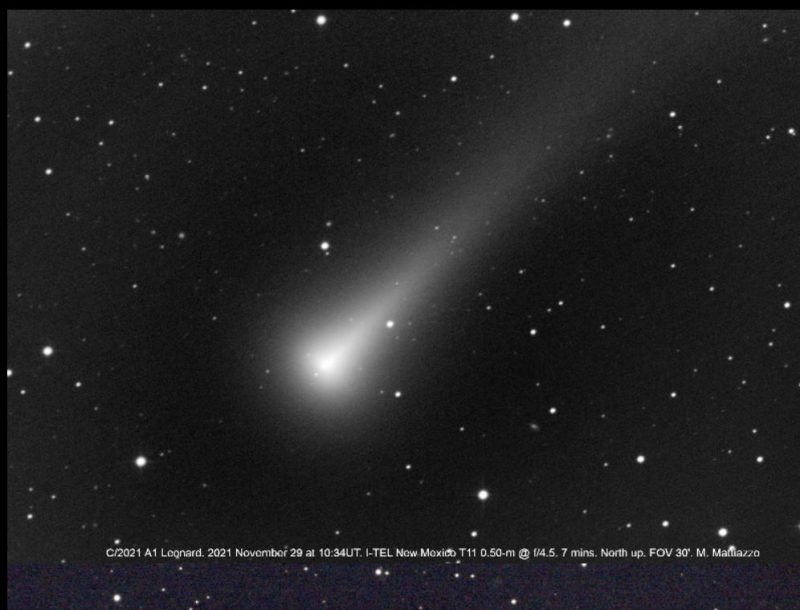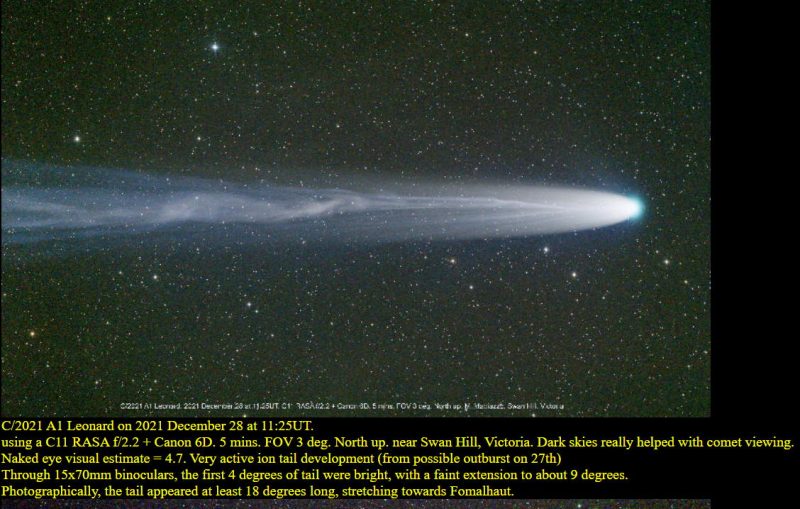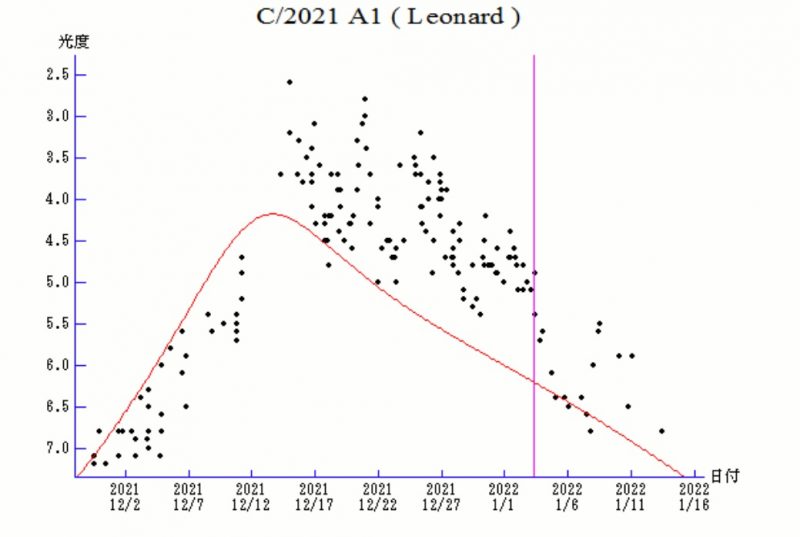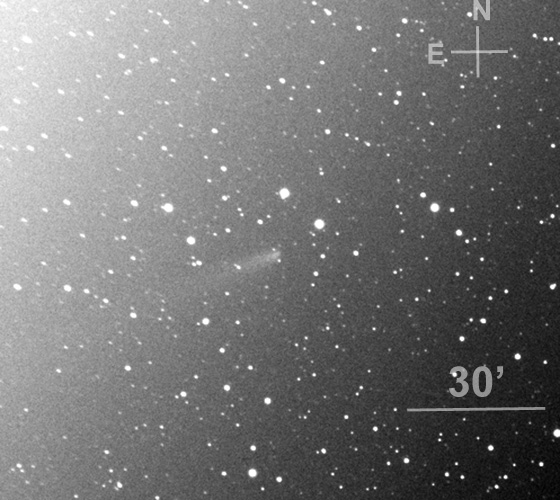
Our brightest comet of the past year has disintegrated. Comet C/2021 A1 (Leonard) – presently in the morning sky as seen from Earth’s Southern Hemisphere – passed nearest the sun at perihelion on January 2, 2022. It is now moving away from the sun and has not only faded but is now missing its two most important parts: its nucleus (core) and its coma (the nebulous envelope surrounding the nucleus, which appears when a comet passes near the sun).
Comet Leonard leaves behind a legacy
As Gregory Leonard, discoverer of Comet C/2021 A1, told EarthSky in an email on March 15:
C/2021 A1’s legacy will likely be the spectacular outburst-induced displays of its ion tail structures. Otherworldly and astonishing are the only descriptions that come to mind when I began viewing the images being posted online by a handful of dedicated expert astrophotographers, particularly after December 19, 2021, when the comet began undergoing strong periodic outburst activity.
Leonard, of the Catalina Sky Survey in Tucson, Arizona, discovered the comet on January 3, 2021, a whole year before its perihelion. At the time of its discovery, the comet was still far from its closest point to the sun. Ultimately, its perihelion distance would bring it well inside the orbit of the Earth and even within the orbit of the next planet inward, Venus.
Early expectations were that the comet would become bright enough to see with the unaided eye. Although that didn’t happen, this comet caused plenty of excitement in late 2021, when it was nearest Earth. See photos of Comet Leonard here, from the EarthSky community.
Comets can be unpredictable
Cometary scientists and amateur astronomers understand that comets are unpredictable in terms of their brightness and appearance. But that doesn’t stop them from predicting how bright comets are going to get.
A comet – often described as a dirty snowball – heats up as it approaches the sun. It is the nucleus, typically only a few miles across, that warms up. The warming core of the comet causes surface material, gas and dust, to be released. This volatile material rising off the warming comet nucleus forms an atmosphere around the nucleus. This is the coma, or head of the comet.
Typically, when a comet goes from any location in the inner solar system to half that distance, a path that might take a few months, it will become 16 times brighter. Astronomers derived this result from observing many comets and taking an average. And notice that it was comet scientists who put that formula together: the same people who understand that comets are unpredictable. They understand that no two comets are the same, so why should they all behave the same? They say:
This is what the comet is supposed to do if it behaves, but maybe it won’t, and we will have the final result only after it has come and gone.
The evolution of Comet Leonard
When Gregory Leonard discovered comet C/2021 A1, it was as far away as Jupiter and only large telescopes could spot it. It behaved well up to the end of November. It brightened more or less as it “should.” But in the last week of November, observers, mainly amateur astronomers who carefully view and image these objects, began to wonder if the comet was beginning to disintegrate. Several signs of unusual behavior caused this alert. The brightness trend slowed, the head of the comet no longer appeared round, and the comet’s path seemed to be veering off course.
Now, months later, we know that the comet did not disintegrate in December. The apparent slowdown in brightness was the result of two factors: moonlight affecting the brightness estimates and a change of volatile gasses the comet was consuming. Moonlight and light pollution limits the size of the coma visible to astronomers who estimate the brightness of a comet. Therefore, the estimate comes in fainter than it would under a dark sky. And as a comet goes from boiling off carbon dioxide to boiling off water, it will sometimes have a small dip in brightness. That’s what happened in late November 2021.
Secondly, a coma that isn’t round often indicates unusual activity with the nucleus. We can’t see the comet’s nucleus due to the thick atmosphere – the coma – that surrounds it. Therefore, the only way to see what the nucleus is doing is to watch the shape and brightness of the coma and changes in the tail. Comet Leonard’s coma was somewhat triangular in shape, with one of the bases of the triangle pointed toward the sun (see top photo). We now know that although unusual, this did not indicate the breakup of the nucleus.
Finally, the comet seemed to be veering off course. A comet expels gas and dust as it heats up, but the nucleus is not evenly active. Comets typically have only a few areas that are active. As the comet expels this material, it induces a jet action, moving the nucleus this way and that as it rotates. A large deviation of the comet’s path usually indicates large jet forces and a small, tiny nucleus. Those two items are characteristics of a disintegrating comet.
The Bortle Limit
On December 2, 2021, the Central Bureau for Astronomical Telegrams issued Electronic Telegram #5077 to dispel the fears that the comet was disintegrating. Daniel Green wrote that the comet was brightening more or less as predicted. It said the positions of the comet for November 29 were not accurate and should not be used to determine the comet’s direction. It then issued predictions for future positions and brightness.
For comets passing near the sun, there is some guidance for astronomers to determine if it will survive or not. This guideline is the Bortle Limit, not to be confused with the Bortle Scale, which measures sky brightness. John Bortle, American amateur astronomer and comet expert, developed and introduced the Bortle Limit to the comet community in 1991. His study of comets that survived their passage past the sun and those that didn’t showed that the closer a comet goes to the sun, the brighter it has to be in order to survive. Although Comet Leonard did not get unusually close to the sun (perihelion was 57 million miles, or 92 million kilometers), its brightness profile suggested it would probably survive. But, then again, no two comets are alike.
Comet Leonard near the sun
As Comet Leonard approached perihelion on January 3, 2022, the brightness began to fluctuate every three to five days. The comet’s tail began to show some complicated structure, possibly due to pieces breaking off the nucleus, revealing new areas that the sun would then heat. By this time, it was difficult to observe. It was located in the evening southern sky, not far from the sun. Yet astronomers continued to monitor it as it faded.


The comet disintegrates
On February 23, 2022, Martin Masek imaged the comet and noticed that it was lacking a central condensation. Other observers confirmed that the comet was now becoming a ghostly streak. The SLOOH telescope in Chile took images that show what is left of the comet.



What happened?
The most likely scenario is that the comet’s nucleus, only a mile in size, either broke up, evaporated away, or both. We know comets to be like dirty snowballs, but not all snowballs are the same. Some are densely packed. Others are fluffy. Some contain rocks (ouch). Others are made of two or more “lobes” squished together. We do not have evidence of the construction of Leonard’s nucleus, all we know is that it put on a fine show, held up through perihelion, and continued for a few more weeks before it disintegrated. And it was the brightest and most observed comet of 2021. As its discoverer stated:
It will be known for the appearance of the tails, some of the best ever observed.
More scientists will study, complete research and write papers on this fine comet. We will get some but not all of the answers we seek.
When the comet named for you disintegrates…
Comets have a mystery not easily revealed.
All we have are images and memories. As a comet discoverer myself, who watched two of my 1st four comets disintegrate and took it in stride, I wonder how other comet discoverers feel about their comets turning into dust and disappearing.
As for the memories, Gregory Leonard writes:
First, for me this comet and its apparition have been an unimagined dream come true, and perhaps like many discoveries it seems to have occurred at the confluence of dedication and luck (professional dedication in my case). It was an utterly surreal experience having a much-anticipated comet sailing dimly overhead for most of 2021, and I was thrilled when it began brightening and tracking across the autumn and winter skies, and of course bearing my family’s name as it was.
Leonard told EarthSky he has fond memories of observing this comet with his wife on many occasions, and when he saw it for the last time, he showed it to his mother, who, he said:
… beamed with delight at seeing and discerning the comet’s coma and tail.
Comet Leonard was already on a path leading it out of the solar system, so everyone knew it was not going to return, and this was our one shot at observing it. But this one was different, as it disappeared before our eyes.
Leonard continued:
As for the comet’s possible demise, I don’t mind the fact that it may have disintegrated. With its post perihelion hyperbolic orbit, I once imagined the comet sometime in the deep future haunting another solar system. Now with its nucleus possibly disintegrated, it may more strangely appear as a ghostly, hyperbolic wisp of dust and gas, if that. Perhaps too there are still some research telescopes tracking its developments and demise, thereby advancing our understanding of cometary behavior. In any case, discovering or simply observing comets for me remains a humbling experience, and my admiration for comets has deepened through the years.
The fickle nature of comets
Comets do what they want. And they go where they go. I have often said that when I find and report a comet discovery, my work is done. Other astronomers will image it and gather accurate positions to calculate its orbit. Other astronomers will name it and announce it to the world. And other astronomers will follow it until it becomes too faint to see. I have no control over anything. The comet might become very bright, it might fizzle, it might hit something. I take no responsibility for the action of the comet. It might bear my name, but the connection ends there.
In his email to EarthSky, Leonard summed it all up this way:
Comets are literally older than dirt and speak to important questions of deep time and our very origins. Comets, particularly those with extraordinary apparitions, somehow insist that we pause to admire their magnificence and mystery. I also appreciate that comets are reminders of the transient nature of … well nature, and all things. And of course, comets are full of surprises, reminding us that we humans are not in control.
Bottom line: Comet Leonard, the bright comet of 2021, has disintegrated. Photos show the nucleus and coma have disappeared, leaving nothing but a ghostly streak.
The post Comet Leonard has disintegrated first appeared on EarthSky.
0 Commentaires